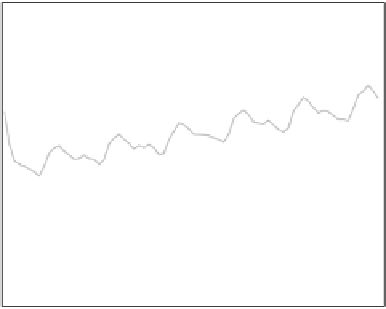Geoscience Reference
In-Depth Information
Fig. 10.4
The temporal cost
function between the truth
and four cases: background
trajectory (
grey
), 3D-Var
(
dashed grey
), “overfit”
(
solid
), and “constrained”
(
dashed black
) methods
10
2
Assim
Forecast
10
1
10
0
10
−1
0
0.5
1
1.5
2
2.5
3
3.5
time
Figure
10.4
shows the ensemble median temporal cost function for the assimilation
and forecast periods for the regular case (transition case is similar) using 12
observations when solved with sequential 3D-Var (at four time steps, marked with
grey, vertical line in the figure) and the two 4D-Var outer-loop schemes. All methods
improve upon the initial guess; however, the forecasts from the 3D-Var and overfit
methods suffer. Once the final set of observations are accounted for, the 3D-Var and
the overfit method follow similar trajectories.
A skill ratio between the total cost functions of the two cost-functions is given
by
A
c
are the overfit and constrained cost functions,
respectively is shown in Fig.
10.5
. Furthermore, the skill ratio between the 3D-
Var and constrained method (
1
A
c
=
A
o
,where
A
o
and
1
A
c
=
A
3
) is shown in grey. For both cases,
the assimilation and forecast periods are shown as a function of the number of
observations assimilated.
In the limit as the cost of
A
3
increases, the ratio goes to zero meaning
that the errors of the overfit or 3D-Var methods are significantly higher than the
constrained. So, as the skill reaches higher values shows, overfitting penalizes the
solution. As before, the overfit method improves only when significantly increasing
the number of observational constraints. This is an important consideration for
geophysical assimilation where in situ data are temporally and spatially sparse. As
more noisy data are assimilated into the sequential 3D-Var solutions, overfitting
becomes a significant issue because it is a series of individual time solutions
unconstrained by the original background. These series of independent fits lose
dynamical consistency as more and more observations are included through time.
The cost functions reveal that the overfit procedure in data-space assimilation
violates the fundamental constraints and produces worse assimilation and forecast-
ing results. Sequential 3D-Var was found to perform similarly for these number of
observations; however, it worsened as the number of observations increased. No
matter the choice of values of
P
and
R
(not shown) or the regular or transition
cases, the overfit method consistently undervalues the cost function and produces
A
o
or






































































Search WWH ::

Custom Search